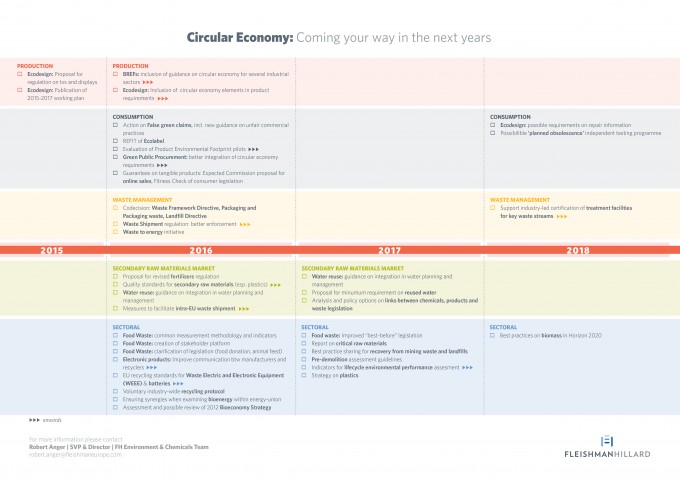The new Circular Economy package includes no fewer than 54 legislative and non-legislative actions to be completed in the next years with a view to “close the loop” of product lifecycles and bring benefits for both the environment and the economy. To help you understand how the actions interact and their impact on business, we have mapped all of them for you.
Time will tell us whether the EU can actually deliver on Circular Economy and beyond, on Better Regulation. Let’s not forget indeed that this package is one of the most striking examples of the Commission’s efforts to make its services work together and turn the Better Regulation agenda into reality.
Are higher recycling targets more ambitious?
The Circular Economy package’s legislative proposals mainly focus on reducing waste and establishing targets. Whilst the Action Plan has been generally positively welcomed by different groups, the lowering of some of the waste reduction, reuse and recycling targets – compared to the 2014 withdrawn proposal – has already been criticized by some as being “not ambitious”. And indeed, what better way for the EU to show strong commitment towards reducing and recycling waste than higher targets?
Things may however be slightly more complex. Taking into account the significant differences that exist between Member States, one could also question whether setting higher targets would be realistic and, perhaps more importantly, the most effective way to actually reduce waste and improve waste management in Europe. With its new package, the Commission seems to have followed the latter reasoning. First, the waste proposals show that ambition can be served by more than higher targets. Improving EPR schemes and acknowledging that a few Member States may need more time to deliver are just a few examples. Second, it is not only about waste as most proposed actions support a long-term strategy that addresses the full product cycle.
Does it close the loop?
Whereas the previous Circular Economy proposal from 2014 was criticized for being too much “waste-focused”, ultimately leading to its withdrawal, the Commission has clearly taken a more holistic approach by working across a number of different policy areas. The Action Plan for the Circular Economy establishes a novel programme with measures covering the whole cycle: from production and consumption to waste management. No fewer than 54 legislative and non-legislative actions are foreseen to be completed in the next years with a view to “close the loop” of product lifecycles and bring benefits for both the environment and the economy.
On paper then, the Commission has delivered. Will these actions ever come to reality and more importantly will they contribute to building a new socio-economic model everyone seems to be calling for? Time will tell us whether the Commission will keep the same momentum and circular economy is more than another buzz word in the EU bubble.
First hints from the Parliament and the Council
As codecision is about to start on the waste proposals, the European Parliament and the Council already gave us a taste of how discussions could look like. In the Parliament, it looks like the EPP and the S&D will be able to work together. While we should of course expect disagreements of several specific points, both groups have stated that the package constitutes a good starting point. The Greens however, and some voices in the ALDE group, have unsurprisingly expressed more disappointment. Meanwhile in the Council, Member States have welcomed the package. When reacting to Commissioner Vella’s presentation though, criticism appeared. The UK raised concerns about not only the role and ambition-level of the targets, but also over the differentiated targets. Sweden, on the other hand, questioned the ambitiousness of the package and stated that Substances of Very High Concern need to be phased-out and called for a landfill ban. Italy responded in a more technical manner and asked for clarification on the definition of waste and the methods for calculating urban waste and recycling targets.
What’s next?
The ambitious programme of actions will now have to be executed in the next few years. The annex to the action plan sets out a timeline showing when we can expect the Commission to get started on each action. Clearly, timing is not as precise as it could (should) be. One thing is very clear though: 2016 is a critical milestone for Circular Economy. It is next year that a significant amount of the activities will be kicked off, covering all stages of the product lifecycle as well as various sectorial actions.
By Lara Visser, Pauline Tawil and Malte Helligsoe
2 Comments
Find Out More
-
Generative AI is changing the search game
May 8, 2025
-
The challenges facing Europe and European leaders at Davos 2025
January 24, 2025




December 17, 2015 | 5:47 PM
Amazing work by my colleague Lara on mapping all 54 actions of the Circular Economy package:https://t.co/HeTmuPDhHg .@KarmenuVella
December 17, 2015 | 5:42 PM
RT @fleishmanEU: Circular Economy 2.0: We’ve mapped all 54 actions for you https://t.co/AE3xFKwvaU